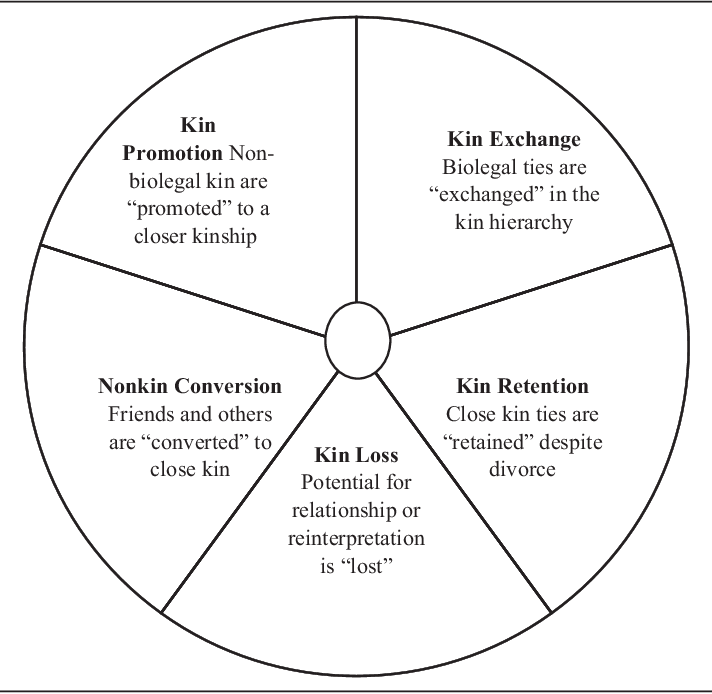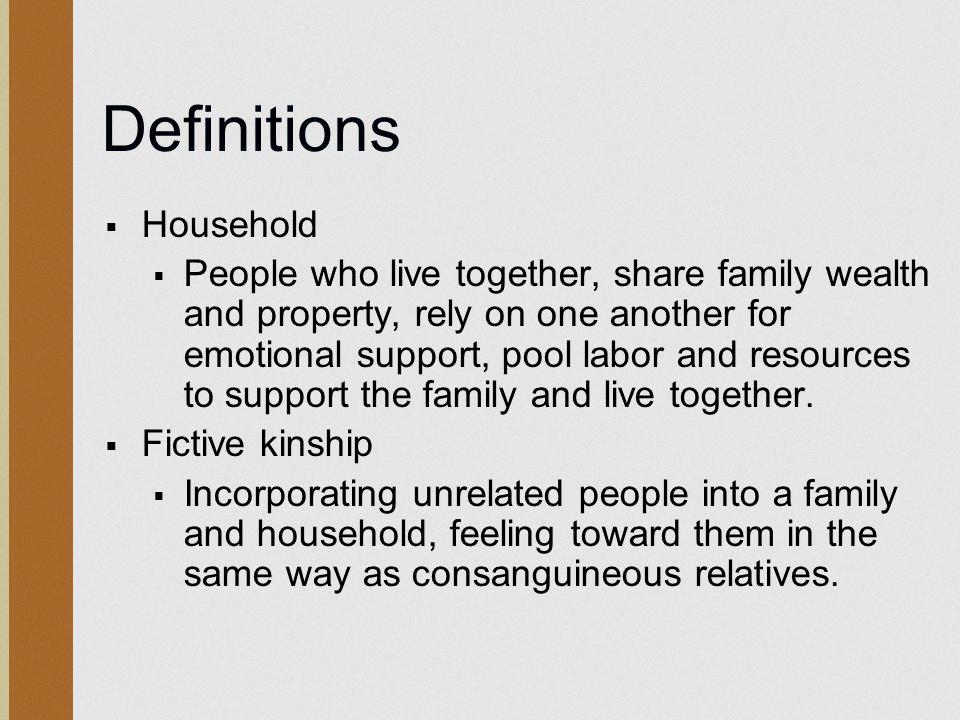Fictive kinship is a term used to describe social relationships that are based on mutual trust, support, and affection rather than blood or legal ties. The concept of fictive kinship has been observed in many cultures around the world, where it serves as a means of extending family networks and creating a sense of community among individuals who may not be related by blood or marriage. In this blog post, we will explore some examples of fictive kinship.
One of the most common examples of fictive kinship is the use of kinship terms to address non-relatives. For instance, calling a close family friend “aunt” or “uncle” even though they are not related by blood or marriage creates a sense of familial connection. This practice is especially common in African American communities, where it is used as a way of extending the family network and providing emotional support.
Another example of fictive kinship is the use of godparents in many cultures. Godparents are often chosen based on thir close relationship with the child’s parents and their willingness to provide emotional and financial support to the child as they grow up. In some cultures, godparents are considered to be part of the child’s extended family, and they may play a significant role in the child’s life.
Fictive kinship can also be observed in the context of same-sex relationships, where individuals may refer to their partners as “husband” or “wife” even though they are not legally married. This practice creates a sense of commitment and permanence in the relationship, and it may also provide legal and financial benefits in some cases.
In some cultures, fictive kinship is used as a way of creating alliances between families or tribes. For example, in Native American cultures, individuals may be adopted into a tribe as a way of creating a sense of belonging and strengthening the community. Similarly, in some African cultures, individuals may be “married” to the clan or tribe as a way of creating an alliance between families.
Fictive kinship is a complex and diverse phenomenon that can be observed in many cultures around the world. Whether it is the use of kinship terms to address non-relatives or the creation of alliances between families, fictive kinship serves as a powerful tool for extending family networks, creating a sense of community, and providing emotional and financial support.
The Benefits of Having Fictive Kin
People have fictive kin for a variety of reasons, but primarily it serves to broaden mutual support networks, create a sense of community, and enhance social control. Fictive kinship is a concept that refers to the relationships between individuals who are not biologically or legally related, but who nonetheless consider theselves to be family. This type of relationship can be found in many different cultures and social contexts, and it often serves as a way for people to extend their familial networks beyond their immediate biological family.
One reason why people have fictive kin is for pooling resources. In many cultures, it is common for people to share resources and support each other during times of need. Fictive kinship can provide a way for people to expand their support networks beyond their immediate family, which can be especially important for marginalized communities who may not have access to the same resources as others.
Another reason why people have fictive kin is to extend their social support. Fictive kin can provide emotional support, advice, and guidance, much like biological family members. This can be especially important for people who may not have close relationships with their biological family or who may be estranged from them.
Lastly, fictive kin can also serve as a way to enhance social control. By establishing strong relationships with individuals outside of one’s immediate family, people can create a sense of accountability and responsibility within their community. This can lead to increased social cohesion and a greater sense of belonging, which can be especially important for those who may feel isolated or marginalized in their society.
People have fictive kin for a variety of reasons, including pooling resources, extending social support, and enhancing social control. This concept is an important aspect of many cultures and can provide a sense of community and belonging for those who may not have strong familial networks.

Are Friends Considered Fictive Kin?
Friends are considered fictive kin. Fictive kinship is a type of relationship that is based on social agreements and is akin to family but not tied to blood or marriage. This means that friends, who are not related by blood or marriage, can have a close relationship that resembles that of a family member. Fictive kinship is often used to descrbe the relationships between individuals who share a close bond, such as godparents, mentors, or close friends. In some cases, these relationships can be as strong or stronger than those between blood relatives or married couples. As such, it is not uncommon for friends to refer to each other as brothers or sisters, or to refer to themselves as a chosen family.
Examples of Fictive Kin
Fictive kin refers to non-blood relatives who are treated as if they were family members. An example of fictive kin is when you refer to your dad’s best friend as “Uncle Pete” even though he’s not your actual uncle. This term is commonly used in anthropology and sociology to describe the social relationships and networks that people create outside of their biological families. Fictive kin can be formed throgh close friendships, cultural traditions, or shared experiences. Quizlet is an online learning platform that offers a variety of study tools and resources for students. It is not an example of fictive kin.
Exploring the Concept of Fictive Kin in Anthropology
In anthropology, fictive kinship is a term used to describe social and emotional relationships that are not based on blood relation or marriage. Instead, fictive kinship is established through shared experiences, mutual support, and emotional connections. These relationships can be as strong and meaningful as those based on consanguineal or affinal ties, and may involve calling someone “aunt” or “uncle” even if they are not biologically related. Fictive kinship is an important aspect of many cultures, and can serve as a way to create and strengthen bonds between individuals and communities.
Can Fictives Serve as Trauma Holders?
Fictives can be trauma holders just like any other alter in a dissociative system. Fictives are alters who take on the identity of fictional characters, and they can hold memories and experiences just like any other alter. Trauma can affect any alter in a system, regardless of their role or identity. Trauma memories can be stored in the individual alter or in the collective memory of the system. It is important to acknowledge and validate the experiences of all alters, including Fictives, to promote healing and integration within the system.

Source: choice360.org
The Meaning of Being a Fictive
Being a fictive means that you are not a real person, but rather a character or creation of the imagination. Fictives can be found in literature, movies, television shows, and even in our own minds when we create stories or characters. Fictives are ofen used to entertain, educate, or convey a message to the audience. They are not real people, but they can have real-life characteristics and emotions that make them relatable to the audience. Fictives can also be used to explore different perspectives, cultures, and experiences that may not be familiar to the audience. being a fictive means that you are a product of the imagination and can serve a variety of purposes in the creative world.
Types of Friends
Friendship can be categorized into four types based on the level of familiarity and intimacy between individuals. The first type is acquaintance, which refers to individuals who know each other casually in a social setting but have not developed a close relationship. The second type is a friend, where individuals have built a level of trust and rapport with each other, but may not share intimate details about their personal lives. The third type is a close friend, where individuals have a deeper level of intimacy and share personal information, interests, and values. the fourth type is a best friend, which is the highest level of friendship where individuals share a deep level of trust, loyalty, and support. As friendship grows, it is natural for individuals to move trough these different types and strengthen their relationships with each other.
Types of Kin
Kinship can be broadly categorized into four types: consanguineal, affinal, fictive, and symbolic.
1. Consanguineal Kinship: This type of kinship includes direct blood relatives such as parents, children, grandparents, and siblings. It is further divided into two subcategories: lineal kinship and collateral kinship. Lineal kinship is the relationship between an individual and thir direct ancestors or descendants, such as a parent-child or grandparent-grandchild relationship. Collateral kinship, on the other hand, refers to the relationship between siblings, cousins, aunts, and uncles.
2. Affinal Kinship: This type of kinship is based on marriage and includes the relationship between an individual and their spouse’s family. For example, a person’s mother-in-law or brother-in-law is considered affinal kin.
3. Fictive Kinship: This type of kinship is not based on blood or marriage but is created through social ties. For example, godparents, adoptive parents, and even close friends may be considered fictive kin.
4. Symbolic Kinship: This type of kinship is based on cultural or symbolic relationships. For example, members of a tribe or clan may refer to each other as brothers or sisters, even if they are not related by blood or marriage. Similarly, members of a religious group may refer to each other as spiritual brothers or sisters.
Understanding the different types of kinship is important in anthropology and sociology as it helps to explain the complex social structures and relationships within a society.
The Meaning of Tertiary Kin
Tertiary kin refers to the individuals who are related to us through our primary or secondary kin. They are the primary kin of our secondary kin or the secondary kin of our primary kin. For instance, the wife of our brother-in-law, who is called salhaj in Hindi, is considered as tertiary kin. This is bcause the brother-in-law is our secondary kin and his wife is the primary kin of our brother-in-law. Tertiary kinship is a way of describing the complex web of relationships that exist within a family or community. It helps us to understand the various degrees of kinship and how individuals are connected to each other in different ways. tertiary kinship plays a crucial role in shaping family dynamics and relationships.

Source: slideplayer.com
The Meaning of Fictive Kin in Slavery
Fictive kin in slavery refers to the bonds of family and community that were formed between enslaved individuals who were not biologically related. During slavery, families were often separated due to the sale of individuals to different plantations or geographic locations. As a result, enslaved individuals created new relationships and support systems with those who shared similar experiences and cultural backgrounds. These newly formed relationships were considered “fictive kin” and coud include individuals who acted as parents, siblings, or extended family members. Fictive kinship provided emotional support, protection, and a sense of belonging for enslaved individuals who were otherwise isolated and vulnerable.
Example of Fictive Kin Group
Fictive kin refers to individuals who are not biologically related to a child but play a significant role in their life as a caregiver or support system. Examples of fictive kin caregivers can include the adoptive parent of the child’s sibling, a nonrelated godparent, a close family friend, a neighbor, a clergy member, or other adult who has a close and caring relationship with the child. Therefore, all the options mentioned above are examples of fictive kin.
Understanding Fictive Kin
Fictive kin on Quizlet refers to a term used to describe a close relationship between individuals who are not related by blood or marriage but share a bond that is similar to that of siblings or cousins. It is a term commonly used in anthropology and sociology to describe social networks that are formed based on shared experiences, values, and common interests. Fictive kin relationships can be formed in various ways, such as through adoption, godparenting, or simply through close friendships. These relationships are often characterized by loyalty, support, and a sense of shared identity. On Quizlet, fictive kin can refer to study groups or communities where members share a common goal of learning and supporting each other in their academic pursuits.
The Role of Fictive Kin in Psychology
In psychology, fictive kin refers to individuals who are not biologically or legally related to a person, but are treated as if they were family members. This term is commonly used to describe the relationships formed in non-traditional families, such as those in which the members are not related by blood or marriage. It is important to note that these relationships are not based on legal or biological ties, but rather on emotional and social connections. Fictive kinship can provide emotional support, practical assistance, and a sense of belonging to individuals who may not have these needs met by thir biological or legal families. It is a way of creating a sense of community and belonging that is not based on traditional family structures.

Types of Kinship
Anthropologists have identified six basic kinship systems that are used by almost all cultures around the world. These systems are known as the Eskimo, Hawaiian, Sudanese, Omaha, Crow, and Iroquois systems.
The Eskimo system is the most commonly used system in North America and Europe. It is also known as the bilateral system, as it emphasizes the nuclear family and the relationships between parents and children. In this system, individuals distinguish between their mother, father, siblings, and grandparents, but there is no distinction between maternal and paternal relatives.
The Hawaiian system is common in Polynesia and other Pacific islands. It is also known as the generational system, as it emphasizes the relationships between generations. In this system, all individuals of the same generation are referred to by the same term. For example, all siblings of the same sex would be referred to by the same term.
The Sudanese system is used in Africa and the Middle East. It is also known as the descriptive system, as it uses specific terms to describe each individual’s relationship to the family. In this system, each individual is givn a unique term based on their relationship to the family, such as “father’s brother” or “mother’s sister.”
The Omaha system is used by some Native American tribes in North America. It is also known as the patrilineal system, as it emphasizes the relationships between fathers and their descendants. In this system, individuals distinguish between their father’s relatives and their mother’s relatives.
The Crow system is also used by some Native American tribes in North America. It is also known as the matrilineal system, as it emphasizes the relationships between mothers and their descendants. In this system, individuals distinguish between their mother’s relatives and their father’s relatives.
The Iroquois system is used by some Native American tribes in North America. It is also known as the bifurcate merging system, as it distinguishes between the mother’s brother and the father’s sister. In this system, individuals distinguish between their mother’s brothers and their father’s sisters, but there is no distinction between maternal and paternal relatives beyond this.
Types of Kinship
There are several ways to classify kinship, but one of the most common approaches is to distinguish between five types of kinship based on the direction of descent and the mode of reckoning. These five types of kinship are bilateral, patrilineal, matrilineal, ambilineal, and cognatic.
Bilateral kinship is the most common type of kinship in modern societies, where individuals are related to both their mother’s and father’s families. This means that kinship is reckoned equally through both parents, and there is no preference given to one side or the other.
Patrilineal kinship, on the other hand, is a system where individuals are related only through their fathers, and kinship is traced through the male line. In patrilineal societies, inheritance typically passes from father to son, and women may have limited rights and status.
Matrilineal kinship is the opposite of patrilineal kinship, where individuals are related only through their mothers, and kinship is traced through the female line. In matrilineal societies, women may hold more power and status, and inheritance may pass from mother to daughter.
Ambilineal kinship is a system where individuals can choose to affiliate with either their mother’s or father’s kin group. This means that kinship can be traced through either parent, depending on the individual’s preference or circumstance.
Cognatic kinship is a system where individuals are related through both their mother’s and father’s families, but one line may be emphasized over the other. This can occur in societies where there is a preference for one gender or where certain roles or responsibilities are associated with one side of the family.
Understanding the diferent types of kinship can help us appreciate the diversity of family structures and social organization across cultures and throughout history.
Conclusion
Fictive kinship is an essential aspect of many cultures and communities. It provides a way for individuals to extend their support networks and create a sense of community beyond their biological or legal families. Examples of fictive kinship can range from referring to a father’s best friend as “uncle” to establishing lifelong friendships that becme like family. Regardless of the specific example, fictive kinship plays a vital role in providing social and emotional support for individuals and communities. It is a powerful reminder that family is not just defined by blood or legal ties, but by the bonds we create with those who are important to us.
